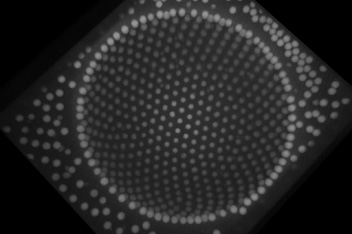Home > Press > Physicists grow pleats in two-dimensional curved spaces
 |
| University of Chicago physicist William Irvine and his colleagues are interested in how the interplay of geometry and light affect the structure of two-dimensional curved spaces, including those of a sphere (shown here), but also domes, waists and barrels. The team has developed methods for finely controlling pleats in these curved spaces, which may be useful in the design of nanoscale materials. (William Irvine) |
Abstract:
A design feature well known in skirts and trousers has now been identified in curved, two-dimensional crystals. As University of Chicago physicist William Irvine and his colleagues report in this week's Nature, crystalline arrays of microscopic particles grown on a negatively curved surface can develop linear defects analogous to fabric pleats. The results will facilitate a more general exploration of defects in curved spaces, including potential applications in engineered materials.
Physicists grow pleats in two-dimensional curved spaces
Chicago, IL | Posted on December 24th, 2010The problem of tiling a curved surface with hexagons is familiar from soccer balls and geodesic domes, in which pentagons are added to accommodate the spherical (positive) curvature. Interacting particles that form hexagonal patterns on a plane — known as ‘colloidal crystals' — adopt these and other types of topological defects when grown on a sphere.
Irvine, an assistant professor in physics, and colleagues have developed an experimental system that allows them to investigate crystal order on surfaces with spatially varying curvature, both positive and negative. On negatively curved surfaces, they observed two types of defect that hadn't been seen before: isolated heptagons (analogous to the pentagons on a sphere) and pleats.
The pleats allow a finer control of crystal order with curvature than is possible with isolated point defects, and may find application in curved structures such as waisted nanotubes (long, thin microscopic cylinders of material that display novel properties), or in materials created by techniques that permit control at the atomic and molecular levels, such as soft lithography or directed self-assembly.
Citation: "Pleats in crystals on curved surfaces," William T.M. Irvine, University of Chicago; Vincenzo Vitelli, Leiden University; and Paul M. Chaikin, New York University, Nature, Dec. 16, 2010, Vol. 468, No. 7326, pp. 947-951.
####
For more information, please click here
Contacts:
Steve Koppes
773.702.8366
Copyright © University of Chicago
If you have a comment, please Contact us.Issuers of news releases, not 7th Wave, Inc. or Nanotechnology Now, are solely responsible for the accuracy of the content.
| Related News Press |
Physics
![]() Simulating magnetization in a Heisenberg quantum spin chain April 5th, 2024
Simulating magnetization in a Heisenberg quantum spin chain April 5th, 2024
News and information
![]() Simulating magnetization in a Heisenberg quantum spin chain April 5th, 2024
Simulating magnetization in a Heisenberg quantum spin chain April 5th, 2024
![]() NRL charters Navy’s quantum inertial navigation path to reduce drift April 5th, 2024
NRL charters Navy’s quantum inertial navigation path to reduce drift April 5th, 2024
![]() Discovery points path to flash-like memory for storing qubits: Rice find could hasten development of nonvolatile quantum memory April 5th, 2024
Discovery points path to flash-like memory for storing qubits: Rice find could hasten development of nonvolatile quantum memory April 5th, 2024
Possible Futures
![]() Discovery points path to flash-like memory for storing qubits: Rice find could hasten development of nonvolatile quantum memory April 5th, 2024
Discovery points path to flash-like memory for storing qubits: Rice find could hasten development of nonvolatile quantum memory April 5th, 2024
![]() With VECSELs towards the quantum internet Fraunhofer: IAF achieves record output power with VECSEL for quantum frequency converters April 5th, 2024
With VECSELs towards the quantum internet Fraunhofer: IAF achieves record output power with VECSEL for quantum frequency converters April 5th, 2024
Academic/Education
![]() Rice University launches Rice Synthetic Biology Institute to improve lives January 12th, 2024
Rice University launches Rice Synthetic Biology Institute to improve lives January 12th, 2024
![]() Multi-institution, $4.6 million NSF grant to fund nanotechnology training September 9th, 2022
Multi-institution, $4.6 million NSF grant to fund nanotechnology training September 9th, 2022
Materials/Metamaterials/Magnetoresistance
![]() Nanoscale CL thermometry with lanthanide-doped heavy-metal oxide in TEM March 8th, 2024
Nanoscale CL thermometry with lanthanide-doped heavy-metal oxide in TEM March 8th, 2024
![]() Focused ion beam technology: A single tool for a wide range of applications January 12th, 2024
Focused ion beam technology: A single tool for a wide range of applications January 12th, 2024
Announcements
![]() NRL charters Navy’s quantum inertial navigation path to reduce drift April 5th, 2024
NRL charters Navy’s quantum inertial navigation path to reduce drift April 5th, 2024
![]() Discovery points path to flash-like memory for storing qubits: Rice find could hasten development of nonvolatile quantum memory April 5th, 2024
Discovery points path to flash-like memory for storing qubits: Rice find could hasten development of nonvolatile quantum memory April 5th, 2024
|
|
||
|
|
||
| The latest news from around the world, FREE | ||
|
|
||
|
|
||
| Premium Products | ||
|
|
||
|
Only the news you want to read!
Learn More |
||
|
|
||
|
Full-service, expert consulting
Learn More |
||
|
|
||








